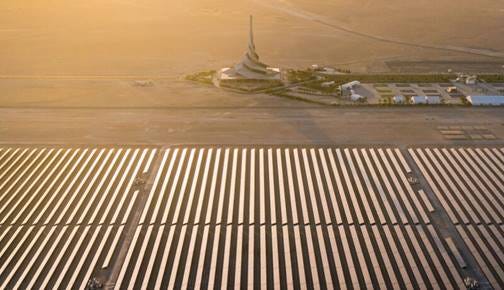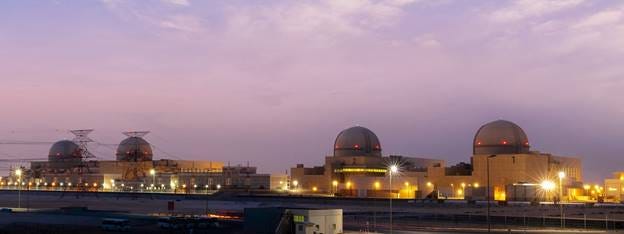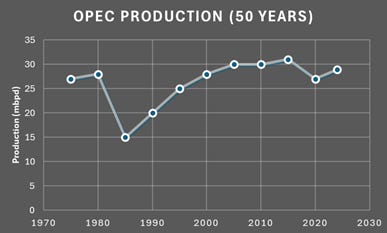Gulf's Energy Evolution: Fueling the Present, Powering the Future
GCC’s role from Oil Dominance to Global Energy Leadership
At the recent World Utilities Congress, I had the privilege of speaking on the Energy-Water-Food Nexus – a critical intersection that lies at the heart of sustainable development for countries navigating the pressures of climate stress and development. Energy access underpins all aspects of human progress and civilization, including water security and food productivity, and without reliable power infrastructure, these interconnected systems falter and fail.
During the conversations, one theme emerged with marked clarity: the Gulf Cooperation Council (GCC) countries - comprising Saudi Arabia, the United Arab Emirates (UAE), Kuwait, Qatar, Oman, and Bahrain, are no longer just oil exporters – accounting for around 25% of global oil production (17 million barrels per day) and having more than 30% of global crude oil reserves. They are emerging as leaders in utility-scale clean energy development, grid modernization, and international energy investments. This transition marks a pivotal shift: from being seen solely as hydrocarbon exporters to becoming integrated energy providers for utility-scale power solutions, helping to meet energy demands of the region and surrounding Global South.
From Pearls to Powerhouses: A GCC Evolution
Less than a century ago, the Gulf states were a collection of desert-dwelling communities whose livelihoods revolved around pearl diving, fishing and trade. Life was shaped by a harsh climate, limited natural resources and major reliance on the sea. Electricity, fresh water and urban development was scarce. In 1932, Bahrain was the first Gulf state to discover oil, followed by Saudi Arabis in 1938. Over the next decades, the oil boom in the region propelled the GCC countries into rapid modernization, transforming the coastal towns into global metropolises like Dubai, Doha and Riyadh.
By the time the GCC was formally established in 1981 amongst member states, the Gulf had already begun transitioning from traditional societies to modern economies. In the following years, the revenues from hydrocarbons were reinvested into infrastructure, education, healthcare and industrialization. Today, the GCC controls over $3 trillion in sovereign funds, and is both an energy supplier and a global investor, with some of the world’s most advanced conventional and renewable energy projects.
With the energy evolution progressing forward, the GCC is once again redefining its global role – this time as a leading utility power innovator.
Energy Challenge of the Global South
Countries across the Global South, including Sub-Saharan Africa, Asia, and parts of Latin America are facing rapidly rising electricity demands driven by population growth and improving economy. By 2040, over 80% of the growth in global electricity demand is expected to come from these emerging markets. However, many countries in these regions struggle with intermittent power, aging or no infrastructure at all, and limited generation capacity. Even today more than 800 million people live without access to electricity, with the vast majority of them being in Sub-Saharan Africa. In Southeast Asia, the demand is expected to grow at 4-5% per year, and this need cannot be met with fragmented systems that are in place today. Utility-scale infrastructure, with centralized generation, transmission and distribution, is critical to addressing these growing demands. This requires capital investments and long-term policy and technology partnerships, which is where the GCC nations are stepping in.
GCC Utilities: From Oil States to Power System Innovators
The GCC countries have invested heavily in clean energy to diversify their economies and have made significant progress in utility-scale renewable energy generation, grid expansions and exporting power to neighboring countries. The models they have set in place are advancing domestic energy goals, as well as shaping energy beyond their borders, especially the Global South. With leadership in both conventional energy and renewable energy, notable projects in the region include:
Solar and Wind Projects
Mohammed bin Rashid Al Maktoum Solar Park in Dubai, targeting 5,000 MW by 2030 and is already one of the largest solar parks in the world.
Sudair Solar PV project in Saudi Arabia, is a 1.5 GW plant that will offset nearly 2.9 million tons of CO2 emissions annually.
Ibri II Solar Plant in Oman, 500 MW project providing electricity to 33,000 homes, reducing emissions by 340,000 tons annually.
Storage and Grid Modernization
Bisha Battery Storage in KSA, at 2.6 GWh, is the largest single-phase battery storage system in the Middle East. Saudi Arabia is deploying more than 11GHh of utility-scale battery storage.
UAE has launched 19GWh hybrid solar + storage projects to strengthen grid reliability
GCC Interconnection Authority (GCCIA), with $1.6B initiative to link all member states, creating a regional grid that enhances grid resiliency and energy security and enables load balancing and exchange during emergencies.
Natural Gas and Nuclear
Natural gas remains the dominant power source, with the lowest carbon intensities per MWh due to high-efficiency combined cycle plants (CCGT).
Barakah Nuclear Power Plant in UAE, with four reactors and a capacity of 5.6 GW, supplies up to 25% of the country’s electricity needs.
Water Desalination
The GCC countries collectively also account for over 40% of the world’s desalinated water production, making this region a world leader in seawater desalination. Ras-Al-Khair Power and Desalination plant in Saudi Arabic is the world’s largest, producing nearly 3 million cubic meters of water per day, closely followed by Jebel Ali plant in Dubai, which produces 2.3 million cubic meters. With arid climates, and water scarcity, countries like Saudi Arabic, Kuwait and the UAE have invested heavily into all types of desalination technologies. These mega plants underline GC’s leadership in integration large scale power generation and cutting-edge desalination to meet local, regional and global needs.
GCC’s role in OPEC: Ensuring Global Energy Security
As core members of OPEC (Organization of Petroleum Exporting Countries), the GCC countries play an important and strategic role in stabilizing global oil markets. There is a long-term focus in diversifying energy resources and investing in low-carbon solutions. Meanwhile, their stewardship of oil and gas supplies ensures affordable and reliable fuel access and price, which is a crucial factor for the Global South that relies primarily on oil and gas for power generation, transportation, agriculture and food supply. This dual role, as stewards of fossil fuels and pioneers in renewable utilities, positions the GCC quite uniquely to bridge the energy transition for developing economies. Saudi Arabia has especially used its OPEC influence to navigate price shocks and ensure overall market stability, enabling developing nations to plan energy investments with less exposure to risk and volatility.
Exporting Power to the Global South
GCC utilities and developers are extending their reach to the Global South and now exporting their supply and expertise across the emerging markets. For example, ACWA Power, headquarters in Saudi Arabic, has a power generation portfolio of nearly 80GW spanning across 14 countries, including South Africa and Egypt, as well as 6.8 million cubic meters/day of water desalination capacity. Masdar, championing UAE’s clean energy, has investments in over 40 countries across Africa and Asia, in solar, wind, waste-to-energy, and hydrogen projects. NEOM’s Green Hydrogen project, with budget of $8B is aiming to produce 600 metric tons per day of green hydrogen to supply clean fuels to India and Africa.
These ventures are not just about exports, but more about co-development to create utility-scale renewable assets, training the local workforce, and offering financing through power purchase agreements (PPPs) and concessional loans. With the GCC countries embedding clean energy in their national strategies and policies, the implications for the Global South are profound. The lower-cost, utility-scale renewable energy projects are producing electricity below 2 cents/kWh, amongst the cheapest globally. Their ability to integrate solar, gas, storage and grid infrastructure offers a blueprint for the emerging countries that is economically feasible. Overall, with the interdependence of all systems on energy, electrification and power access provide clean water access through desalination operations, and fertilizer for agriculture, enhancing food security.
A Gulf-Powered Future
The GCC countries have undergone one of the most impressive transformations of the 20th and 21st centuries. From pearl divers and nomads to pioneers in energy, they are uniquely equipped to support the next phase of global electrification, energy access and social and economic transformation. They are leveraging their energy wealth and strategic foresight to not only support their own progress, but also the broader progress of emerging economies. By combining their financial strength, clear policies, and technological innovations, the Gulf states are proving to not only be energy exporters, but as indispensable energy partners. This is exactly what the world needs, especially the Global South: reliable, affordable and clean energy solutions.
The story of the Gulf is far from over – it is entering a bold new chapter defined not only by the fossil fuels in the ground, but by ideas, technologies and partnerships that will shape the energy landscape of the future. These are exciting times for the region, and I look forward to how this next chapter of energy leadership and innovation unfolds.







